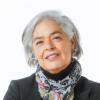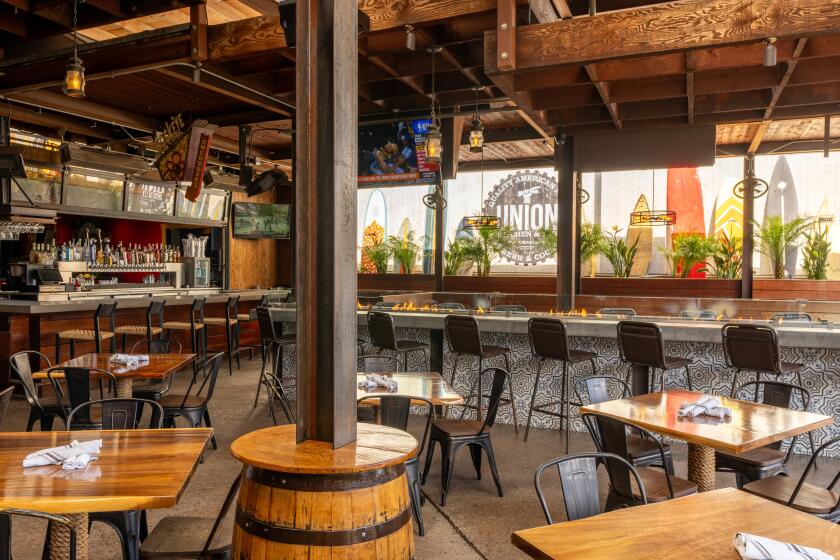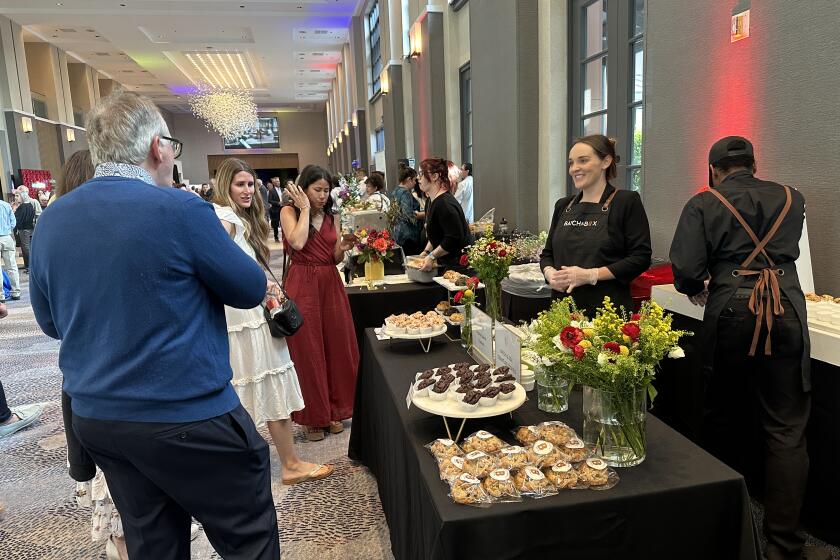‘Salt, Fat, Acid, Heat’s’ Samin Nosrat on success, San Diego and finding her superpower
The author and host of the popular Netflix series makes her hometown debut at the Balboa Theatre on Friday
Samin Nosrat needed a rest.
Rocketing to culinary stardom will do that to you.
“Until this summer, when I took six weeks off, I was going nonstop for seven years,” said Nosrat, 39, a San Diego native who grew up in University City. Nosrat catapulted to fame with the 2017 publication of her first book, “Salt, Fat, Acid, Heat: Mastering the Elements of Good Cooking,” a New York Times best-seller which was then turned into the wildly popular Netflix series by the same name.
The cookbook and the TV show each won a coveted James Beard award and set Nosrat’s success trajectory into overdrive, with offers for increasingly prestigious projects: writing the Eat column for The New York Times’ Sunday magazine; editing the just-published “Best American Food Writing 2019”; landing a contract for her second book, “What to Cook;” and developing another TV series that will likely take her on more global culinary journeys.
Until her summer respite, she said, “I didn’t have time to figure out who I am. There are so many shiny opportunities that get thrown at me now, I needed to silence the outside voices, I needed to figure out the things I really care about and do the things I care about.”
Nosrat will bring her clearer mind — and no doubt, her joy-filled, infectious laugh — to downtown San Diego on Friday in what will be her hometown debut. Her appearance is part of the ArtPower at UC San Diego special event series. Nosrat will sit down for a conversation with Evan Kleiman,the Los Angeles-based James Beard award-winning chef, KCRW radio show host and author.
Nosrat is used to being in the company of culinary A-listers. She counts among her mentors Chez Panisse and local food movement demigod Alice Waters, America’s premier food-science writer, and fellow Netflix denizen, Michael Pollan (“The Omnivore’s Dilemma,” “The Botany of Desire,” “Cooked”), and internationally celebrated Tuscan butcher and salumi star Dario Cecchini.
But since the publication and airing of “Salt, Fat, Acid, Heat,” it’s Nosrat who has been at the center of the food universe, racking up accolades and superlatives, in addition to opportunities. Consider:
- The best-selling book earned the 2018 James Beard Award for Best General Cookbook and was cited as one of the best books of 2017 by The Washington Post, Publishers Weekly, The Atlantic, Bon Appétit, Newsday, The Seattle Times and more than a dozen other publications. Eater called it “one of the seminal food books of the last decade,” and praised Nosrat’s ability to explore the science behind cooking techniques and help home cooks understand and apply them. The influential dining website named Nosrat its 2018 Chef of the Year.
- Waters described Nosrat as “America’s next great cooking teacher,” while the San Francisco Chronicle called her “one of the brightest stars in the national food landscape” and the book is “a masterclass in providing new cooking skills to the general public.” NPR even evoked the J-Word, proclaiming Nosrat “the next Julia Child.”
- The Netflix series — which took Nosrat to Italy (fat), Japan (salt), Mexico (acid) and back home to Berkeley (heat) — brought her animated writing style to life. It was described by The Washington Post as “unlike any other food show on TV,” and the Boston Globe’s Devra First unabashedly gushed over her: “Nosrat’s on-screen instruction is as enlightening as the cookbook ... in which she teaches not so much recipes as how to cook. But it’s Nosrat’s down-to-earth style, bursts of laughter, and expressions of delight that make her feel like a friend. After an era of domestic goddesses like Martha Stewart and Nigella Lawson, Nosrat leaves behind the image of polished perfection for something more real. She was called ‘the next Julia Child’ by NPR, but the joy of Samin Nosrat is that she is very much herself.”
All this about someone who grew up feeling like she never fit in anywhere. Not in the cultural, socioeconomically limbo between the decidedly Persian-centric home kept by her middle-class Iranian immigrant parents or out in the sun-kissed world of wealthier La Jolla. Not at school, where this dreamer of “weird, crazy, big things” had a hard time finding her tribe. Not even at the beach, her favorite place in the world, where she longed to surf but found the SoCal scene inhospitable.
Spoiler alert: She would later find her tribe, learn how to surf and turn feeling like an outside into her superpower.
In a recent phone interview, which was occasionally punctuated by Nosrat’s signature laugh and the goings on of her puppy Fava Bean, she spoke about her upcoming San Diego return, what kind of TV show would “hurt her soul” and how her mother taught her much more than how to make a perfectly crisp rice tahdig.
This is her life: Coming to San Diego won’t really be like coming home for Nosrat. “I think it’ll be really interesting. In a lot of ways, I’m so distant from my San Diego life,” she said. “I’m actually really curious and excited to see who shows up — ‘This is your life!’ ... Since the book and the show, people dig me up and send me messages.”
Neither here nor there: The disconnect from Nosrat’s San Diego life began while she was still here. “ I have a big imagination, I always dreamt like weird, crazy big things, and I always felt I didn’t fit in.” Fueling that feeling was her mother’s insistence on creating a home life that centered on the family’s Persian culture (Nosrat’s parents were from Iran and came to the U.S. around the time of the Iranian Revolution in 1979.) They ate at Persian restaurants in La Jolla and Irvine, they shopped for groceries at the Balboa International Market and Nosrat and her siblings attended a Persian school to learn how to read and write Farsi as well as “to connect with our community and connect with our culture,” she said. “My mom created Iran in our house. ... When we left home, we were American, when we came home, we were in Iran.” When Nosrat visited Iran and met her cousins, she got identity whiplash again. “Well, I’m not them either,” she realized.
The whole turning lemons into lemonade thing: “That feeling of not fitting in, that has sort of followed me my whole life,” she said. “But that feeling of outsideness, now it’s my superpower! It’s created a priority to make work that’s inclusive to everyone.” That superpower manifests in shining a light on those who rarely get seen on food TV, including people of color, home cooks and older women, whom she affectionately calls in interviews “the grannies.” She knows the power of inclusive representation well: “What I wouldn’t have given as a little kid in San Diego to have seen someone like me on TV!” she told Eater. “In second grade, I was called a terrorist. My whole life has been this. So if I can mean that for somebody else — for another little kid, or not even a little kid — then that’s what I wanted to do.”
A superpower is good, but she also has her Kryptonite: Her puppy, the aforementioned mutt Fava Bean, controls her life, is “the talk of my neighborhood and the ruler of my existence.”
Lessons from Maman: Nosrat’s adorable mother makes a cameo in “Heat,” the fourth episode of the Netflix series, and the two make a comedy routine out of making that most Persian of preparations, tahdig. They explain, through laughter, how the crispy, pan-fried rice dish is traditionally considered a bellwether for whether a woman is marriage material in Iran. The two share the same exuberance when the pan is flipped over to reveal the dark, browned layer of tahdig and viewers can’t help but feel the mother-daughter love on the screen. But Nosrat said that the most important lessons she learned from her mother weren’t actually about cooking. “My mom is absolutely responsible for making me who I am and instilling my values in me,” she said. “For example, my mom has always believed in quality goods, paying for well-made things. She was obsessed with good ingredients ... organic — back then — and she didn’t let us eat sugar. ... It was all about what tastes best. She wanted things to taste like Iran. And then I moved to Berkeley, the temple of local and organic. Now, I put a lot of value into things that are handmade and the people that make them. That’s a direct through-line in my life from my mom.”
Getting out your comfort zone: Nosrat said challenging herself at La Jolla High School in an unexpected way gave her confidence and helped her feel like part of a community. “The very best thing that I did, and it was totally serendipitous, was I joined the high school cross-country team. Why? I don’t even like running! I wasn’t even good, but it was the first time I was part of this group of ragtag girls,” she said. Former La Jolla High teacher and cross country coach Thomas Dorman recognized her real talent was writing and encouraged her to run with that . “He was the one who told me I could write. He was really, really supportive.” They’re still in touch.
The 20-year-long overnight success: What’s gotten lost in the dizzying exposure — what Nosrat describes as “the exponential attention” — she’s gotten since the show came out is that she has spent years learning, teaching, honing her skills, creating the foundation from which she could write the book, and making her career happen. “It’s not like it happened at once,” she said. “To me, I’ve never viewed myself as the undeniable authority on anything. It’s more, there’s something I’ve learned and I love sharing it with people. ... There’s no teaching without learning.” That’s something she said she learned from Pollan, who wrote the foreword in “Salt, Fat, Acid Heat.”
Opportunities weren’t always handed to her: Nosrat is a woman who makes things happen. As she recounts in “Salt, Fat, Acid, Heat’s” introduction, she was an English literature major at UC Berkeley when she became obsessed with Chez Panisse after a life-changing first meal at the landmark restaurant. So she wrote owner Alice Waters a letter asking if she could work as a busser there, despite having no restaurant experience. She handed the letter and her résumé to the Chez Panisse floor manager — with whom she had had a memorable meeting while dining there — and she immediately got the job. Not long after, mesmerized by the fresh produce and goings-on in the kitchen, she successfully convinced the chefs to let her work with them. Her internship launched her fascination for cooking techniques, flavors, ingredients and nuances and she studied in the kitchen and at home.
A show is born: Nosrat’s gift for the written request worked its magic again when she wrote Michael Pollan asking if she could audit his graduate class in food journalism. So began a decades-long teacher-student relationship. Except it would be Nosrat who later taught Pollan how to cook. She appeared in an episode of Pollan’s Netflix series “Cooked” and caught the attention of the production crew as a natural on camera, according to Eater. The episode’s director, Caroline Suh, turned out to be Nosrat’s “guardian angel,” and the driving force in getting “Salt, Fat, Acid, Heat” into Netflix’s hands.
Keeping her passport handy: Nosrat said she’s in the fun, creative, brainstorming process for a new TV series. It won’t be based on her second book, since it’s not done yet. One thing she does know, is that it will involve travel adventure, bringing viewers along for the journey as she learns something new. No studio-shot “stand and stir” food show for her. “I think it would hurt my soul,” she said.
Getting out of your comfort zone, Part 2: When she was growing up, the Nosrat family spent a lot of time at the beach and some of those outings had lasting impact. Nosrat recounts in the introduction to “Salt, Fat, Acid, Heat” how her curly hair, wet from the sea, would sometimes drip briny flavor on her food and she became aware of salt’s transformative effect. Going to the beach was also a source of alienation. “I have always loved the ocean more than anything else, and I always, always wanted to surf,” she said. “In the ‘80s and ‘90s, there was no place for girls in surfing, definitely not brown girls. So I knew, OK, I’m not welcome here.” She feels welcome in Northern California, where she has made a circle of close friends and was encouraged by a group of women surfers to finally take it up. “And now, I’m so happy I eventually got to do it,” she said. Learning how to surf while writing her book was instrumental in putting her in the reader’s mindset — she could see how she needed to help coax cooks through the frustration of failure. At that time, she said, “it was very useful to be very terrible at something.”
ArtPower at UC San Diego presents Samin Nosrat
When: 8 p.m. Friday.
Where: Balboa Theatre, 868 Fourth Ave., downtown San Diego
Tickets: $25-$45; limited number of $15 tickets available for UCSD students
Phone: (619) 570-1100
Get U-T Arts & Culture on Thursdays
A San Diego insider’s look at what talented artists are bringing to the stage, screen, galleries and more.
You may occasionally receive promotional content from the San Diego Union-Tribune.






